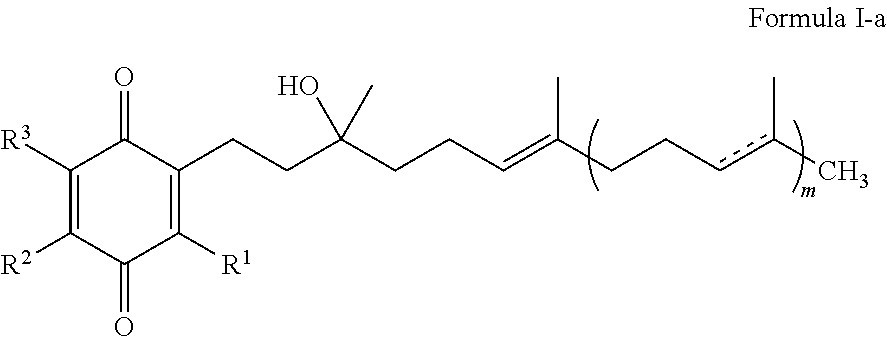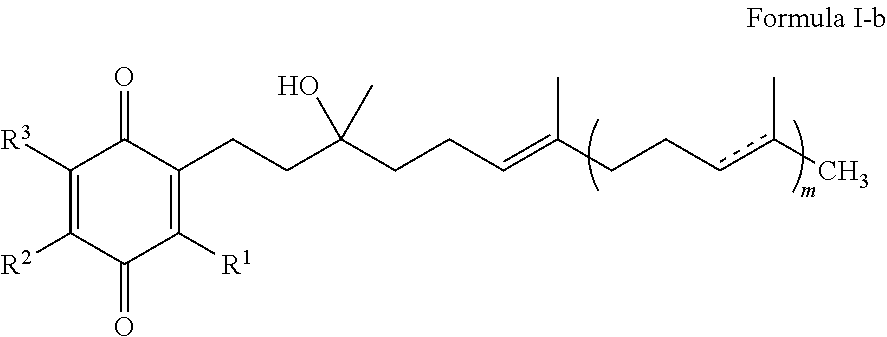Formulations of quinones for the treatment of ophthalmic diseases
- Summary
- Abstract
- Description
- Claims
- Application Information
AI Technical Summary
Benefits of technology
Problems solved by technology
Method used
Image
Examples
example 1
FRDA Cell Line Assay and Initial Screen for Effective Compounds
[0209]The quinone of Formula I is tested for its ability to rescue Friedreich's Ataxia (FRDA) fibroblast cells obtained from the Coriell Cell Repositories (Camden, N.J.; repository number GM04078), from stress effected by addition of L-buthionine-(S,R)-sulfoximine (BSO), as described in Jauslin et al., Hum. Mol. Genet. 11 (24):3055 (2002), Jauslin et al., FASEB J. 17:1972-4 (2003), and International Patent Application WO 2004 / 003565. EC50 of test compound is determined and compared.
[0210]MEM (a medium enriched in amino acids and vitamins, catalog no. 1-31F24-I) and Medium 199 (M199, catalog no. 1-21F22-I) with Earle's Balanced Salts, without phenol red, are purchased from Bioconcept. Fetal Calf Serum is obtained from PAA Laboratories. Basic fibroblast growth factor and epidermal growth factor are purchased from PeproTech. Penicillin-streptomycin-glutamine mix, L-buthionine (S,R)-sulfoximine, and insulin from bovine pancr...
example 2
LHON Cell Line Assay and Initial Screen for Effective Compounds
[0218]The quinones of Formula I are screened as described in Example 1, but substituting FRDA cells with Leber's Hereditary Optic Neuropathy (LHON) cells obtained from the Coriell Cell Repositories (Camden, N.J.; repository number GM03858). The quinones are tested for their ability to rescue human dermal fibroblasts from LHON patients from oxidative stress.
[0219]The quinones of Formula I are considered active if they exhibit protection against LHON with an EC50 of less than about 100 nM.
example 3
Huntington's Cell Line Assay and Initial Screen for Effective Compounds
[0220]The quinones of Formula I are tested using the screen as described in Example 1, but substituting FRDA cells with Huntington's cells obtained from the Coriell Cell Repositories (Camden, N.J.; repository number GM 04281). The quinones are tested for their ability to rescue human dermal fibroblasts from Huntington's patients from oxidative stress.
[0221]The quinones of Formula I are considered active if they exhibit protection against Huntington's with an EC50 of less than about 100 nM.
PUM
| Property | Measurement | Unit |
|---|---|---|
| Pharmaceutically acceptable | aaaaa | aaaaa |
Abstract
Description
Claims
Application Information
 Login to View More
Login to View More - R&D
- Intellectual Property
- Life Sciences
- Materials
- Tech Scout
- Unparalleled Data Quality
- Higher Quality Content
- 60% Fewer Hallucinations
Browse by: Latest US Patents, China's latest patents, Technical Efficacy Thesaurus, Application Domain, Technology Topic, Popular Technical Reports.
© 2025 PatSnap. All rights reserved.Legal|Privacy policy|Modern Slavery Act Transparency Statement|Sitemap|About US| Contact US: help@patsnap.com



